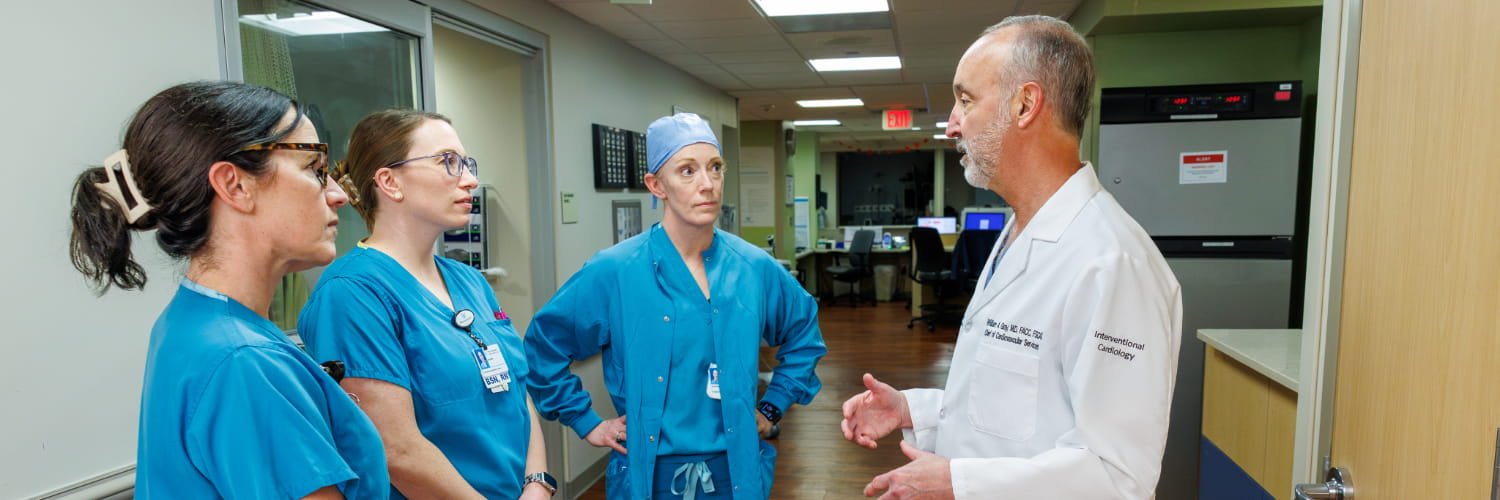From personal journeys to cardiac breakthroughs

From personal journeys to cardiac breakthroughs
William Gray, MD, remembers exactly when his desire to do more than individually treat patients began. He was a Fellow at Brown University in 1989 when the Chief of Cardiology asked whether he had considered research after graduation.
"No, I'm not really interested in research," the young physician said.
"Oh, I see," the Chief replied, leaning back in his chair. "You want to only take care of patients one at a time."
"It's funny," Dr. Gray thinks back now. "I don't think that would have resonated so much with many other people, but for me, it crystallized the value of research."
Basel Ramlawi, MD, was 11 when his father developed stomach cancer. He immersed himself in helping his father fight the disease, and by the time he was finishing high school, he was assisting an oncologist with research projects. At McGill University in Montreal, the chance to learn from an expert surgeon made him realize that operating on patients was his calling. Ultimately, he was pulled into the cardiovascular field by the swift, positive impact a surgeon can have. He trained with some of the best in the field, including in Paris under Alain Carpentier, known as the "father of mitral valve repair."
"Being in the operating room is where it all came together," Dr. Ramlawi says. "It allowed me to coalesce the medical field, the sciences, research and the human aspect. You're taking care of this patient. Their families are waiting outside. It's an enormous, rewarding responsibility."
Leading heart research at Lankenau Heart Institute
From those beginnings, Dr. Ramlawi and Dr. Gray are now a resident faculty duo that has spearheaded Lankenau Institute for Medical Research's (LIMR) cardiac research to new heights. As co-Directors of the Lankenau Heart Institute, they provide the setting for LIMR's pioneering trials, creating opportunities in patient care that are unavailable in most health systems. (Lankenau Heart Institute and LIMR are both on Lankenau Medical Center's campus.)
"The leadership, innovativeness and skill of Dr. Gray and Dr. Ramlawi have transformed what was already a strong cardiovascular program into the backbone of LIMR's research efforts," says George Prendergast, PhD, President and CEO of LIMR. "When patients are looking for high quality care, it resonates when the physicians conduct research that allows them to perform cutting-edge procedures not offered elsewhere. And when your clinical leaders value research, it produces a halo effect that attracts more talent and enhances your program even further."
"Meaningful research requires more than great ideas — it demands coordination, investment, and a shared vision," says Trudy Mazzone, MS, BSRT (R), Vice President of Cardiovascular Services and co-Director of Lankenau Heart Institute at Main Line Health. "At Main Line Health, we work behind the scenes to align clinical operations, research strategy and funding pathways so that our physician leaders can continue advancing care in real time. It's about building a system where innovation is not only possible—it's expected, and accessible to every patient who walks through our doors."
Pioneering clinical trials and stroke prevention
In addition to his role at LIMR, Dr. Gray is also the System Chief of the Cardiovascular Division at Main Line Health, a Professor of Medicine at Thomas Jefferson University and holder of the Phillip D. Robinson Endowed Chair in Cardiovascular Medicine. He came to LIMR and Lankenau Heart Institute in 2016 and has been the national principal investigator for numerous trials. Many are first-in-human trials, allowing developers to assess new medical devices before extensive testing.
"We were able to contribute to those types of trials just as the technology started to appear," the interventional cardiologist says. "The Food and Drug Administration was interested in safety and effectiveness, and we were well-situated to ride that wave by virtue of our excellent patient care and strong reputation as a research center. It's been a great experience I could not have imagined when starting out 35 years ago."
He initially focused on coronary research, leading to the development of bare metal stents and then drug-coated ones to keep blood flowing. He branched into treating vascular diseases, such as those affecting the legs, kidneys and aorta. Now, he works to develop devices to treat valve disorders and other structural heart conditions.
His longest sustained research effort has drawn considerable attention nationally: advancing the treatment of carotid artery disease to prevent stroke.
Revolutionizing aortic valve replacement with TAVR
Dr. Ramlawi, Chief of Cardiothoracic Surgery at Main Line Health, has been a leader in advancing transcatheter aortic valve replacement (TAVR). The procedure is minimally invasive, entailing smaller incisions than open-heart valve surgery, and is used to replace narrowed aortic valves that don't open fully. As a national principal investigator, he has worked to broaden TAVR's use nationally and internationally to treat the bicuspid valve and lower-risk patients.
Expanding access to advanced cardiac treatments
"The procedure has brought aortic valve treatment to the masses," Dr. Ramlawi says. "Initially, it was brought to the sickest, oldest and most frail individuals. Through research done partly at LIMR, I was able to help bring this to lower risk, younger individuals."
Dr. Ramlawi was driven to make his father proud, and he succeeded. His father got to see him graduate from medical school before dying from cancer. Now, in addition to a busy surgical practice, he spends his time teaching and developing novel approaches and devices to treat heart valves and aortic aneurysms with the least invasive, most durable approach.
Sharing knowledge to shape the future of heart care
The results of Dr. Gray's and Dr. Ramlawi's combined research and clinical prowess extend beyond the Philadelphia region. LIMR cardiac researchers have increased their publication production sixfold since 2019. Dr. Gray frequently speaks at national and international conferences about the advances in clinical trials he has led.
Dr. Ramlawi flew to Osaka and worked with a heart care team on performing Japan's first transcatheter mitral valve replacement.
Putting patients first — in research and in life
They have found that their perspective on medicine has changed similarly over the years. To them, decisions are not just about patients' longevity.
"You have to ask what their goals in life are," Dr. Gray says. "Some people want to live long enough to see their kids and grandkids get married or be able to take a hike with those grandkids. A lot of people don't worry so much about longevity, but their quality of life."
Now, they are focused on keeping Lankenau Heart Institute at the forefront of patient care and LIMR at the forefront of research to ensure the latest in technology continues.
"I see an even rosier future," Dr. Ramlawi says. "I'm very happy Bill and I are so aligned on our vision for LIMR and Lankenau Heart Institute. Best-in-class care is our goal. That's what patients should expect from us, right?"
Next steps:
Make an appointment with Basel Ramlawi, MD
Make an appointment with William Gray, MD
Learn more about heart and vascular care at Main Line Health
Learn more about cardiac research at LIMR
 Content you want, delivered to your inbox
Content you want, delivered to your inbox
Want to get the latest health and wellness articles delivered right to your inbox?
Subscribe to the Well Ahead Newsletter.
